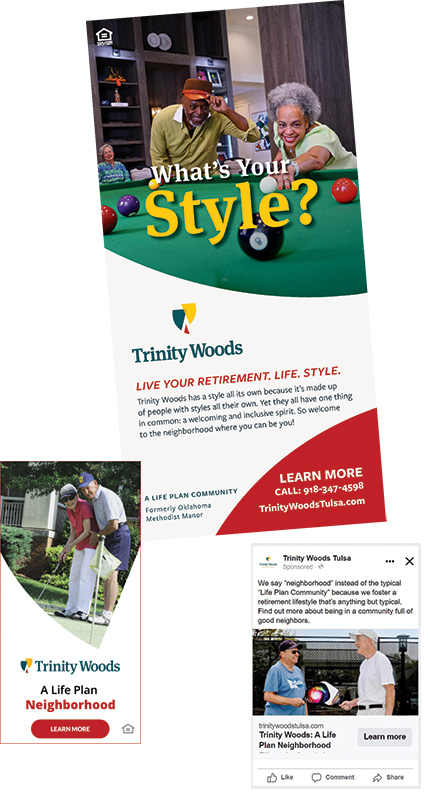When developing a new campaign strategy (or refreshing an old one), it’s critical to have a guiding approach that outlines all aspects of the campaign so it aligns with your community’s goals. For example, if you have many leads but need help nurturing them to a sale, using brand awareness tactics as the focus of your campaign wouldn’t be aligned with your goals.
Similarly, it’s important to keep in mind that not all leads are created equally. In our high-tech world, chances are many of your leads come from digital channels and tactics. These leads typically require more nurturing through the sales funnel compared to leads from other channels, such as a referral from an existing resident.
With this information in mind, creating a strategy for your campaign based on your goals and audience will yield the best results and save you a lot of time, money and aggravation. By following these four steps, you can develop a marketing campaign roadmap that will help you navigate your road to success.
1. Identify the goals of the overall campaign
The first step in any campaign strategy is identifying what your business needs are and determining your goals based on those needs. For example, you may need “X” number of sales (or deposits) by a certain date to achieve occupancy goals. Or, you might need to reposition your community based on new additions to your product that differentiate you from competitors in your market.
Once you determine your business needs, you can set your campaign goals. For example, for a plan that’s focused on lead generation, you’ll want to work backward from your sales goal to determine how many sales-qualified leads you need based on your sales conversion rate, and then how many marketing-qualified leads you need to meet that sales-qualified lead goal.
Need help?
Click here to try our marketing calculator to determine your marketing and sales goals in senior living.
Then you can project how many leads each tactic in your campaign will generate per month and track your progress against these goals. We find that needs and goals vary by client but determining these elements from the beginning are vital to running a successful campaign. How will you know if your budget and tactics will enable you to reach your goals without completing this exercise?
2. Identify your target audience
Once you outline the needs and goals of the campaign, the next step for your campaign strategy is to determine your target audience. Research as much as you can about these personas. Where do prospects spend their time, in person and online? What channels do they use to consume media?
In addition to demographics (like age, income and location), be sure to identify your target market’s interests, behaviors and preferences. If your community has a strong religious affiliation, you may find success targeting prospects who are similarly affiliated. If your community offers more luxurious amenities and upscale living options, you’ll want to target a more affluent prospect who will appreciate and find value in your community’s higher-quality features.

3. Identify the initiatives for your campaign and the goals of each
If your goal is to increase awareness of your community, your campaign strategy may focus on more traditional media tactics, such as print and outdoor (think: billboards), or online display ads. These types of ads reach people who aren’t actively searching for senior living and helps keep your brand fresh in their minds.
If your goal is to generate new leads, you might instead focus on pay per click (PPC; also known as paid search) ads, which display to users who are using specific search terms that align with your products and services. Social media ads and direct mail promoting an upcoming event are also effective in driving new interest to the lifestyle your community offers.
Maybe your community already has a healthy database of active leads and you need help nurturing them further down the sales funnel. In this scenario, display remarketing ads (online ads served to prospects who have already visited your website) that offer a new piece of enticing information or an incentive (such as pre-construction savings) can help. You could also deploy lifestyle and event invitation emails to try to generate foot traffic and give existing prospects a reason — other than a tour — to visit your community.
Keep in mind that while your focus may be on one stage of the buying journey, you’ll want to establish a well-rounded plan to ensure prospects in all phases of their journey are supported.
4. Craft messaging that best supports each initiative
As you begin developing creative, focus on the aspects of your community that are distinct from competitors and that your target audience values. If you’re the only community around that has a running track, but your target prospects don’t enjoy running, ads promoting that feature and lifestyle are unlikely to be effective. To gain market share, your unique selling propositions (USPs) must be both unique and valued.
Softer messaging and calls to action typically work best early in the prospect’s journey. At this stage, prospects are just getting to know your brand — so they’re not as likely to respond to pricing incentives, for instance. Calls to actions need to be less committal; this is where you should promote aspirational aspects of your community and establish your community as a trusted source for information and education. Sparked interest in your community’s lifestyle and playing into your target market’s aspirations can help move the prospect further down the sales funnel.
More direct messaging and calls to action typically perform best when used in the mid-funnel stages. Prospects who are further in the buying journey are interested in more information on your product, pricing and availability. Once a prospect gets to the middle of the sales funnel, they’re usually feeling more comfortable and getting closer to taking action. At this point, you want to entice them with something that wasn’t available at the top of funnel. Keep in mind, prospects receiving mid-funnel tactics have already raised their hand and expressed interest in some way, so they aren’t as put off by more direct sales messaging. It’s a good time to message around incentives and special offers.
The slow road is the fast road
You might be tempted to skip these steps to get creative in the market NOW. Instead, we’d advocate for maintaining your market presence with more brand-focused ads while you take the time to establish your campaign strategy. The increase in effectiveness and conversion will make it well worth the extra time.
Documenting your campaign strategy provides you and your team with guidance in every stage of implementation and becomes a source of truth against which to measure results. This kind of tool provides insights so other people (or departments) working on the campaign can make decisions that will best serve the overall strategy.



